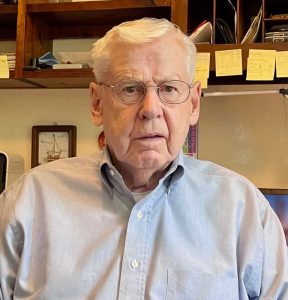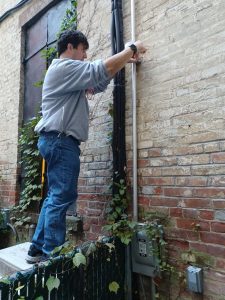Known as Project FRESH Air, it brings faculty and students together with local schools to monitor air quality, an on-the-ground way of building awareness of climate change and educating the next generation of climate activists.
McGroddy made a gift in support of the project. Then he learned about the University’s core curriculum revisions, aimed at fostering cross-disciplinary thinking, and decided to give again—seeing in the University’s various efforts the kind of forward-looking approach in which he has long sought to invest.

His new gift created the James C. McGroddy Award for Innovation in Education, which carries a cash prize. In April, the University announced the first recipients: three professors who had found an inventive way of teaching chemistry students about machine learning. (See related story.)
The gift reflects McGroddy’s deeply held belief in preparing students to handle future challenges—and seize future opportunities—that are just now taking shape.
“I see Fordham as aiming to lead change, being ahead of the wave rather than following, and that’s what motivates my support,” he said.
Forward-Looking Jesuit Education
McGroddy has long been familiar with Fordham. His father and brother graduated from the University, and he attended Jesuit schools himself—New York’s Regis High School and St. Joseph’s University in Philadelphia—before earning his doctorate in physics from the University of Maryland.
His views on education gelled during his student years and during his 32-year career with IBM, from which he retired as senior vice president of research in 1996. At St. Joseph’s, he studied electronic physics, a nontraditional major that combined in-depth education in science fundamentals with full-time work experience to prepare students for careers in the transistor and digital revolution, then in its infancy.
McGroddy credits much of his career success to that major, and education became one of his career’s through lines. During and after his IBM career, he focused on university-industry collaboration and served as a visiting lecturer and member of multiple university advisory boards and visiting committees, both in the U.S. and abroad. During a sabbatical from IBM he was a visiting professor at the Technical University of Denmark, and he later helped establish the IT University of Copenhagen.
Preparation for Health Care, Energy, Immunology Challenges
Since his retirement from IBM, a major focus for his philanthropy and consulting has been education, particularly science and technology education that balances “learning about” with “learning how to,” he said.
The emerging challenges for today’s students include developing alternative energy sources; building on “amazing” progress in the fields of genetic science and immunology; and changing the nation’s health care industry to create a system that achieves better results as well as lower costs, he said.
“Helping students develop a profile that will enable them to succeed, and lead, in the world which we imperfectly see ahead must be the key driver of educational innovation, and will be the hallmark of leading universities in the challenging years before us,” McGroddy said.
Learn about other opportunities to invest in academic excellence or other pillars of the Fordham experience at the site for the University’s $350 million fundraising campaign, Cura Personalis | For Every Fordham Student. To inquire about giving to any area of the University, please contact Michael Boyd, senior associate vice president for development and university relations, at 212-636-6525 or [email protected].
]]>“We want to set up a network of air quality sensors around the city and map out the air quality—particularly in the Bronx—and help students become scientifically literate activists in their communities,” said Stephen Holler, Ph.D., chair and associate professor of Fordham’s physics and engineering physics department, who is co-leading the project with Usha Sankar, Ph.D., an advanced lecturer in biological sciences. “Through our project, we can start a dialogue about climate change and say, ‘Let’s do something to fix it together.’”
Air pollution triggers many respiratory illnesses. One in 13 Americans have asthma, according to the Asthma and Allergy Foundation of America. Among the five New York City boroughs, the Bronx has the highest percentage of asthma diagnoses for children up to age 12, as well as the highest child asthma hospitalization rates.
The goal of Project FRESH Air (Fordham Regional Environmental Sensor for Healthy Air) is to combat those statistics with education.
Holler has started setting up a network of PurpleAir air quality sensors in middle and high schools in the Bronx and upper Manhattan, including Jonas Bronck Academy, All Hallows High School, and Cristo Rey New York High School. Each sensor—not just the project sensors in the city, but independent Purple Air sensors worldwide—records data 24/7. The data is viewable on an interactive map in real time.

The project garners interest because air quality is an issue people can relate to, Holler said.
“I don’t think that many people in the Bronx are interested in the fact that it’s going to be one or two degrees warmer in a few decades. If you’re living paycheck to paycheck and worried about your kids, that’s not your high priority, right? So we’re tackling this issue by looking at it through an air quality perspective,” said Holler, who has previously worked with local students on climate change projects. “Air quality will degrade as the climate changes. We’ll have more pollution and particulate matter in the air from combustion sources, vehicles, and the urban environment, which irritate the lungs and aggravate asthma. But this is an immediate problem that we can address.”
The FRESH Air team, which includes Fordham faculty, undergraduates, and middle and high school educators, is now working on ways to incorporate the sensors and their data into middle and high school curricula. Students will be able to build their own handheld sensors with special kits. They will also be tasked with plotting air quality data from their sensors and searching for trends.
“They can plot the data in Microsoft Excel or Google Sheets and correlate it with factors like weather. Was the air quality better on this day or another? Was there a holiday? And they can start to understand the dynamics and patterns that are happening in their community,” Holler said.
This fall through a virtual webinar, the FRESH Air team introduced the project to students and families at Jonas Bronck Academy, located one block away from the Rose Hill campus.
“The day after the informational session, our students were asking questions to all five of us teachers,” said Alexiander Soler, a seventh grade science teacher at JBA. “‘What is air quality? How does that relate to us? How does it connect to asthma?’”
Next spring, JBA will integrate Project FRESH Air into its sixth, seventh, and eighth grade curricula. The sixth graders will learn about air pollution and how it’s measured, the seventh graders will learn about health implications affected by air quality, and the eighth graders will learn how technology improves data collection, while using the sensors and their data, said Soler. Fordham undergraduates will also work with students on a weekly basis to help them analyze their data, said Holler. About 260 students at JBA will benefit from this curriculum, said Soler.
“These sensors are effectively going to be permanent installations,” Holler said. “Over the next two to three years, we are looking to have about 25 schools on this project.”
The project originally emerged from the Higher Education Incubator and Think Tank led by Eva Badowska, Ph.D., dean of the faculty of arts and sciences and associate vice president for arts and sciences, and Anne Fernald, Ph.D., professor of English and special adviser to the provost, before the pandemic. It is being largely funded by James C. McGroddy, a former senior vice president and director of research at IBM who wants to promote STEM education, especially for minority and underserved populations.
“The purpose of science is to gain an understanding of the natural world and its impact on our lives. This project will create a real scenario that our students can identify with, and hopefully increase their interest in science and becoming problem-solvers,” said Soler. “It will allow our students to see how science truly affects their lives.”
]]>